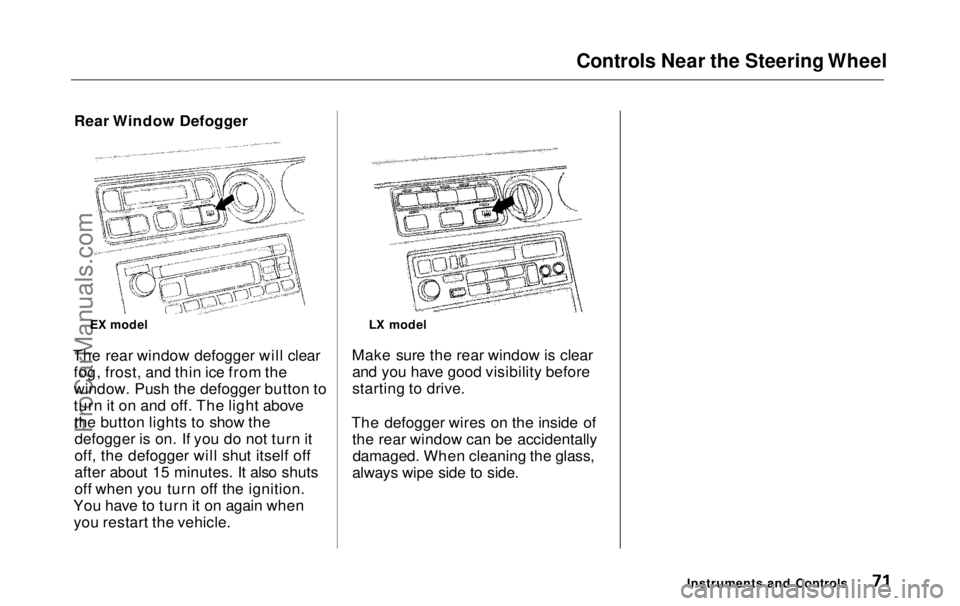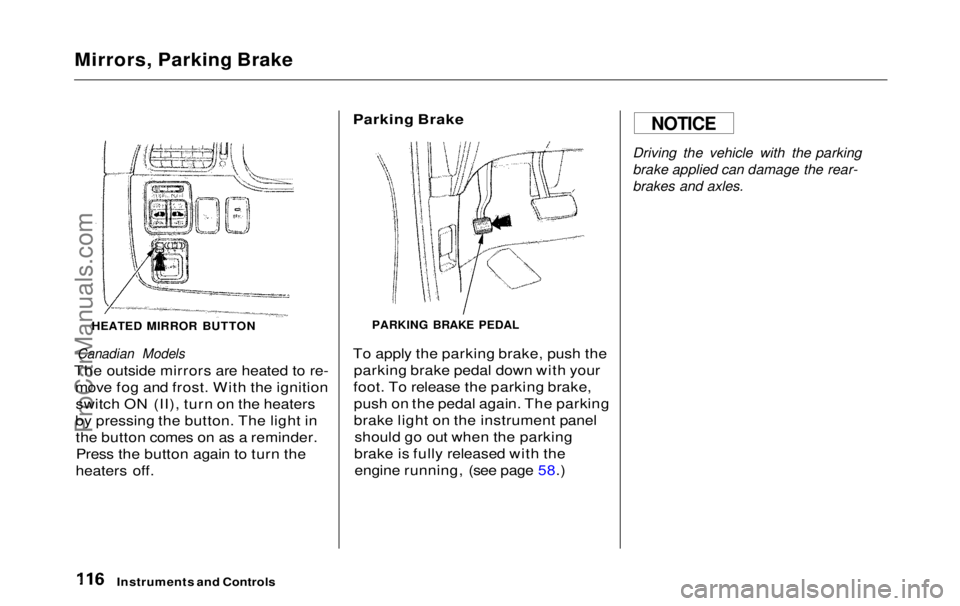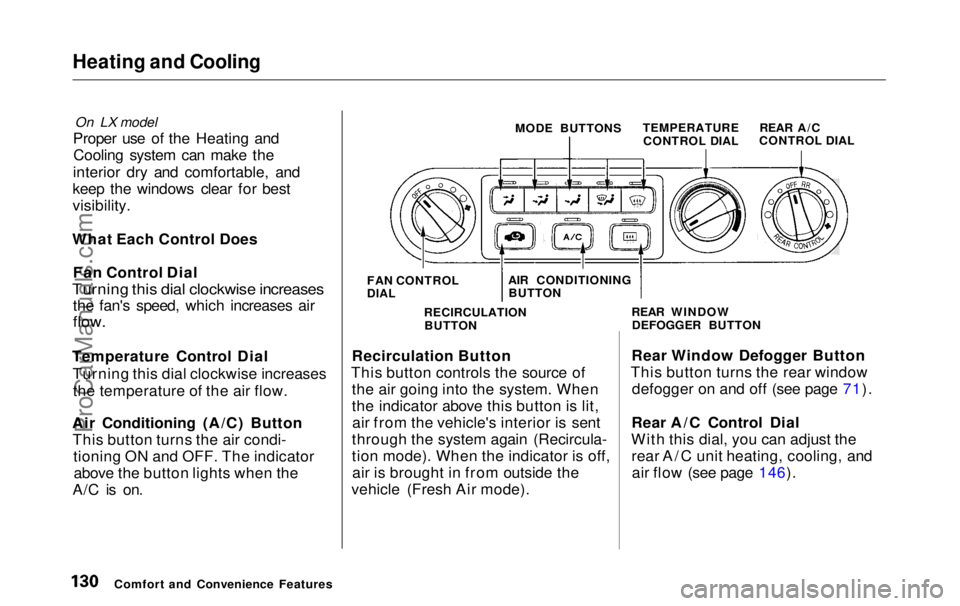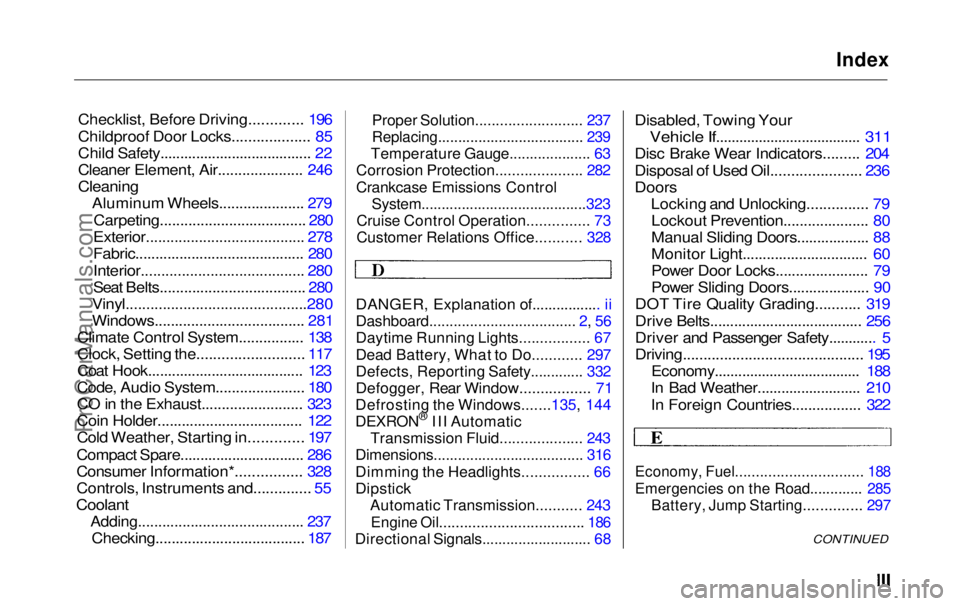1999 HONDA ODYSSEY fog light
[x] Cancel search: fog lightPage 5 of 343

Your Vehicle at a Glance
*
:
To use the horn, press the pad around the "H" logo.
TRACTION CONTROL SYSTEM
(P.207) HEADLIGHTS/
TURN SIGNALS
(P.66/68)
HAZARD WARNING
LIGHTS
(P.70)
DIGITAL CLOCK
(P.117)
REAR WINDOW
DEFOGGER(P.71)
LIGHT CONTROL
SWITCH (P.125)
WINDSHIELD
WIPERS/WASHERS
(P.68/70)
CRUISE
CONTROL
(P.73)
HORN*
STEERING WHEEL
ADJUSTMENT (P.72)
POWER SLIDING
DOOR SWITCHES(P.90)
MIRROR
CONTROLS (P.115)
REMOTE AUDIO
CONTROLS
(P.179)
CRUISE
CONTROL
(P.73)
ProCarManuals.comMain Menu s t
Page 56 of 343

Instruments and Controls
This section gives information about
the controls and displays that
contribute to the daily operation of
your Honda. All the essential
controls are within easy reach.
Control Locations............................ 56
Indicator Lights................................ 57
Gauges.............................................. 62
Controls Near the Steering
Wheel........................................65
Headlights...................................
. 66
Automatic Lightin g
Off
Feature......................................67
Daytime Running Lights............. 67
Instrument Panel Brightness..... 67
Turn Signals................................. 68
Windshield Wipers.....................
. 68
Windshield Washers..................
. 70
Rear Windo w
Wiper and
Washer......................................70
Hazard Warning........................... 70
Rear Window Defogger.............. 71
Steering Wheel Adjustment....... 72
Steering Wheel Controls ................ 73
Cruise Control.............................. 73
Remote Audio Controls .............. 76
Keys and Locks................................ 76
Keys............................................... 76
Immobilizer System..................... 77
Ignition Switch............................. 78
Power Door Locks....................... 79
Remote Transmitter.................... 81Childproof Door Locks............... 85
Tailgate......................................... 85
Glove Box..................................... 87
Sliding Doors.................................... 88
Manual Sliding Doors.................. 88
Power Sliding Doors.................... 90
Important Safety Precautions.... 94
HomeLink Universal Transmitter.................................. 95
Seats.................................................. 99
Passenger Seating....................... 99
Seat Adjustments....................... 100
Driver's Seat Power
Adjustments........................... 102
Armrests..................................... 103
Head Restraints......................... 104
Third Seat Access...................... 105 Moving the Second Row Bucket Seat............................ 106
Removing the Bucket Seats in the Second Row................. 108
Removing the Bench Seat in the Second Row................. 109
Folding the Third Seat.............. 110
Power Windows............................. 113
Mirrors............................................ 115 Parking Brake................................ 116
Digital Clock................................... 117
Center Table................................... 117
Beverage Holder............................ 118
Sunglasses Holder......................... 120
Sun Visor......................................... 121
Vanity Mirror................................. 121 Rear Compartment........................ 122Center Pocket................................ 122
Coin Holder.................................... 122
Storage Box.................................... 123 Coat Hook....................................... 123
Accessory Power Sockets............. 124 Interior Lights................................ 125
Instruments and ControlsProCarManuals.comMain Menu s t
Page 66 of 343

Controls Near the Steering Wheel
The two levers on the steering column contain controls for driving
features you use most often. The left
lever controls the turn signals,
headlights, and high beams. The
right lever controls the windshield
washers and wipers.
The switches for the hazard warning lights and rear window defogger are
located to the right of the steering
column.
The controls under the left air vent are for the TCS, the cruise control,
the power sliding doors and the
power mirrors.
The tilt adjustment lever on the underside of the steering column
allows you to tilt the steering wheel.
* To use the horn, press the pad around the "H" logo.
HAZARD
WARNING
LIGHTS
LIGHT CONTROL
SWITCH
MIRROR
CONTROL
HEADLIGHTS/
TURN SIGNALS REAR WINDOW
DEFOGGER
Instruments and Controls
POWER
SLIDING
DOOR
TRACTION
CONTROLSYSTEM WINDSHIELD
WIPERS/WASHERS
SHIFT
LEVER
HORN'
CRUISE
CONTROL TILT
ADJUSTMENTProCarManuals.comMain Menu Table of Contents s t
Page 72 of 343

Controls Near the Steering Wheel
Rear Window Defogger
The rear window defogger will clear fog, frost, and thin ice from the
window. Push the defogger button to
turn it on and off. The light abovethe button lights to show thedefogger is on. If you do not turn it
off, the defogger will shut itself off
after about 15 minutes. It also shuts
off when you turn off the ignition.
You have to turn it on again when you restart the vehicle. Make sure the rear window is clear
and you have good visibility before
starting to drive.
The defogger wires on the inside of the rear window can be accidentallydamaged. When cleaning the glass,
always wipe side to side.
Instruments and Controls
EX model
LX modelProCarManuals.comMain Menu Table of Contents s t
Page 117 of 343

Mirrors, Parking Brake
HEATED MIRROR BUTTON
Canadian Models
The outside mirrors are heated to re- move fog and frost. With the ignitionswitch ON (II), turn on the heaters
by pressing the button. The light in the button comes on as a reminder.Press the button again to turn the
heaters off.
Parking Brake
PARKING BRAKE PEDAL
To apply the parking brake, push the parking brake pedal down with your
foot. To release the parking brake, push on the pedal again. The parking
brake light on the instrument panel should go out when the parking
brake is fully released with the engine running, (see page 58.)
Driving the vehicle with the parking
brake applied can damage the rear-
brakes and axles.
Instruments and Controls
NOTICEProCarManuals.comMain Menu Table of Contents s t
Page 131 of 343

Heating and Cooling
On LX model
Proper use of the Heating and Cooling system can make the
interior dry and comfortable, and
keep the windows clear for best
visibility.
What Each Control Does Fan Control Dial
Turning this dial clockwise increases
the fan's speed, which increases air
flow.
Temperature Control Dial Turning this dial clockwise increasesthe temperature of the air flow.
Air Conditioning (A/C) Button This button turns the air condi- tioning ON and OFF. The indicatorabove the button lights when the
A/C is on. MODE BUTTONS
TEMPERATURE
CONTROL DIAL
Recirculation Button
This button controls the source of the air going into the system. When
the indicator above this button is lit,air from the vehicle's interior is sent
through the system again (Recircula-
tion mode). When the indicator is off, air is brought in from outside the
vehicle (Fresh Air mode). Rear Window Defogger Button
This button turns the rear window defogger on and off (see page 71).
Rear A/C Control Dial
With this dial, you can adjust the rear A/C unit heating, cooling, andair flow (see page 146).
Comfort and Convenience Features FAN CONTROL
DIAL
AIR CONDITIONING
BUTTON
RECIRCULATION BUTTON REAR WINDOW
DEFOGGER BUTTON REAR A/C
CONTROL DIALProCarManuals.comMain Menu Table of Contents s t
Page 211 of 343

Driving in Bad Weather
Rain, fog, and snow conditions re-quire a different driving technique
because of reduced traction and
visibility. Keep your vehicle well- maintained and exercise greater
caution when you need to drive in
bad weather. The cruise control should not be used in these condi-
tions.
Driving Technique — Always drive
slower than you would in dry
weather. It takes your vehicle longer to react, even in conditions that mayseem just barely damp. Applysmooth, even pressure to all the
controls. Abrupt steering wheel
movements or sudden, hard appli-
cation of the brakes can cause loss of control in wet weather. Be extra
cautious for the first few miles (kilometers) of driving while you
adjust to the change in driving
conditions. This is especially true in snow. A person can forget some
snow-driving techniques during the
summer months. Practice is needed
to relearn those skills.
Exercise extra caution when driving
in rain after a long dry spell. After
months of dry weather, the first
rains bring oil to the surface of the
roadway, making it slippery. Visibility — Being able to see
clearly in all directions and being
visible to other drivers are important in all weather conditions. This ismore difficult in bad weather. To beseen more clearly during daylight
hours, turn on your headlights.
Inspect your windshield wipers and
washers frequently. Keep the wind- shield washer reservoir full of the
proper fluid. Have the windshield
wiper blades replaced if they start to streak the windshield or leave parts
unwiped. Use the defroster and air conditioning to keep the windows
from fogging up on the inside (see
pages 135 and 144 ).
DrivingProCarManuals.comMain Menu Table of Contents s t
Page 335 of 343

Index
Checklist, Before Driving............. 196
Childproof Door Locks................... 85
Child Safety...................................... 22
Cleaner Element, Air..................... 246
Cleaning
Aluminum Wheels..................... 279
Carpeting.................................... 280
Exterior....................................... 278
Fabric.......................................... 280
Interior........................................ 280
Seat Belts.................................... 280
Vinyl............................................280
Windows..................................... 281
Climate Control System................ 138
Clock, Setting the.......................... 117
Coat Hook....................................... 123
Code, Audio System...................... 180
CO in the Exhaust......................... 323
Coin Holder.................................... 122
Cold Weather, Starting in............. 197
Compact Spare............................... 286
Consumer Information*................ 328
Controls, Instruments and.............. 55
Coolant
Adding......................................... 237
Checking..................................... 187
Proper Solution.......................... 237
Replacing.................................... 239
Temperature Gauge.................... 63
Corrosion Protection..................... 282
Crankcase Emissions Control
System.........................................323
Cruise Control Operation............... 73
Customer Relations Office........... 328
DANGER, Explanation of................. ii
Dashboard.................................... 2, 56
Daytime Running Lights................. 67
Dead Battery, What to Do............ 297
Defects, Reporting Safety............. 332
Defogger, Rear Window................. 71
Defrosting the Windows.......135, 144
DEXRON ®
III Automatic
Transmission Fluid.................... 243
Dimensions..................................... 316
Dimming the Headlights................ 66
Dipstick
Automatic Transmission........... 243
Engine Oil................................... 186
Directional Signals........................... 68
Disabled, Towing Your
Vehicle If..................................... 311
Disc Brake Wear Indicators......... 204
Disposal of Used Oil...................... 236
Doors
Locking and Unlocking............... 79Lockout Prevention..................... 80
Manual Sliding Doors.................. 88
Monitor Light............................... 60
Power Door Locks....................... 79
Power Sliding Doors.................... 90
DOT Tire Quality Grading........... 319
Drive Belts...................................... 256
Driver and Passenger Safety............ 5
Driving............................................ 195 Economy..................................... 188
In Bad Weather.......................... 210
In Foreign Countries................. 322
Economy, Fuel............................... 188
Emergencies on the Road............. 285
Battery, Jump Starting.............. 297
CONTINUEDProCarManuals.comMain Menu s t